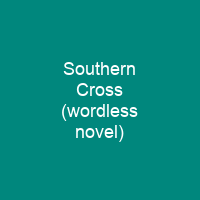Laurence Hyde’s Southern Cross is the sole wordless novel by a Canadian artist. Published in 1951, its 118 wood-engraved images narrate the impact of atomic testing on Pacific islanders. Hyde made the book to express his anger at the US military’s nuclear tests in the Bikini Atoll.
About Southern Cross (wordless novel) in brief

The child witnesses the death of the parents and destruction of their environment from the ensuing atomic tests. Each image is 4 by 3 inches, centred at the top third of the page and with broad margins. Blacks overwhelms the figures they surround, and abstract images contrast with realistic detail in the flora and fauna. The one exception is of the bomb detonating, a 7 in × 6 in full-page image that bleeds off the page. The book was published in a limited edition by Ward Ritchie Press in 1951 on Japanese paper with the images on the recto and the verso left blank. It was republished twice in 2007 with a deluxe facsimile edition by Drawn & Quarterly.
You want to know more about Southern Cross (wordless novel)?
This page is based on the article Southern Cross (wordless novel) published in Wikipedia (as of Dec. 04, 2020) and was automatically summarized using artificial intelligence.







